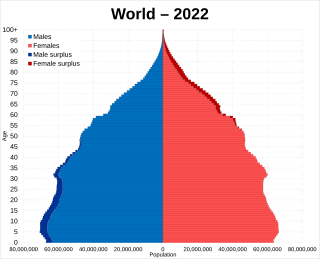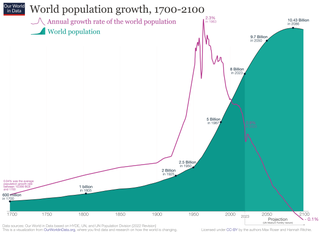
Extreme poverty is the most severe type of poverty, defined by the United Nations (UN) as "a condition characterized by severe deprivation of basic human needs, including food, safe drinking water, sanitation facilities, health, shelter, education and information. It depends not only on income but also on access to services". Historically, other definitions have been proposed within the United Nations.
Population is the term typically used to refer to the number of people in a single area. Governments conduct a census to quantify the size of a resident population within a given jurisdiction. The term is also applied to non-human animals, microorganisms, and plants, and has specific uses within such fields as ecology and genetics.

Demographic features of the population of South Korea include population density, ethnicity, education level, health of the populace, economic status, religious affiliations, and other aspects of the population. The common language and especially race are viewed as important elements by South Koreans in terms of identity, more than citizenship.

Population ageing is an increasing median age in a population because of declining fertility rates and rising life expectancy. Most countries have rising life expectancy and an ageing population, trends that emerged first in developed countries but are now seen in virtually all developing countries. That is the case for every country in the world except the 18 countries designated as "demographic outliers" by the United Nations. The aged population is currently at its highest level in human history. The UN predicts the rate of population ageing in the 21st century will exceed that of the previous century. The number of people aged 60 years and over has tripled since 1950 and reached 600 million in 2000 and surpassed 700 million in 2006. It is projected that the combined senior and geriatric population will reach 2.1 billion by 2050. Countries vary significantly in terms of the degree and pace of ageing, and the UN expects populations that began ageing later will have less time to adapt to its implications.

Population growth is the increase in the number of people in a population or dispersed group. Actual global human population growth amounts to around 83 million annually, or 1.1% per year. The global population has grown from 1 billion in 1800 to 7.9 billion in 2020. The UN projected population to keep growing, and estimates have put the total population at 8.6 billion by mid-2030, 9.8 billion by mid-2050 and 11.2 billion by 2100. However, some academics outside the UN have increasingly developed human population models that account for additional downward pressures on population growth; in such a scenario population would peak before 2100. Others have challenged many recent population projections as having underestimated population growth.
Human overpopulation describes a concern that human populations may become too large to be sustained by their environment or resources in the long term. The topic is usually discussed in the context of world population, though it may concern individual nations, regions, and cities.
In its Proclamation on Aging, the United Nations General Assembly decided to declare 1999 as the International Year of Older Persons (IYOP). The proclamation was launched on 1 October 1998, the International Day of Older Persons, by United Nations Secretary General Kofi Annan.

The population of Africa has grown rapidly over the past century and consequently shows a large youth bulge, further reinforced by a low life expectancy of below 50 years in some African countries. Total population as of 2020 is estimated to be more than 1.3 billion, with a growth rate of more than 2.5% p.a. The total fertility rate for Africa is 4.7 as of 2018, the highest in the world according to the World Bank. The most populous African country is Nigeria with over 206 million inhabitants as of 2020 and a growth rate of 2.6% p.a.

Environmental issues in the United States include climate change, energy, species conservation, invasive species, deforestation, mining, nuclear accidents, pesticides, pollution, waste and over-population. Despite taking hundreds of measures, the rate of environmental issues is increasing rapidly instead of reducing. The United States is among the most significant emitters of greenhouse gasses in the world. In terms of both total and per capita emissions, it is among the largest contributors. The climate policy of the United States has a major influence on the world.

In world demographics, the world population is the total number of humans currently living. It was estimated by the United Nations to have exceeded eight billion in mid-November 2022. It took around 300,000 years of human prehistory and history for the human population to reach a billion and only 222 years more to reach 8 billion.
The InterAcademy Panel Statement on Population Growth is an international scientist consensus document discussing and demanding a halt of the population expansion. This was the first worldwide joint statement of academies of sciences, and their cooperative InterAcademy Panel on International Issues. It was signed by 58 member academies and began as follows.
Let 1994 be remembered as the year when the people of the world decided to act together for the benefit of future generations.
Health in Egypt refers to the overall health of the population of Egypt.

Water scarcity in Africa is predicted to reach dangerously high levels by 2025 when it is estimated that about two-thirds of the world's population may suffer from fresh water shortage. The main causes of water scarcity in Africa are physical and economic scarcity, rapid population growth, and climate change. Water scarcity is the lack of fresh water resources to meet the standard water demand. Although Sub-Saharan Africa has a plentiful supply of rainwater, it is seasonal and unevenly distributed, leading to frequent floods and droughts. Additionally, prevalent economic development and poverty issues, compounded with rapid population growth and rural-urban migration have rendered Sub-Saharan Africa as the world's poorest and least developed region.
7 Billion Actions is a worldwide campaign established by the United Nations Population Fund (UNFPA) in 2011 to commemorate the world population milestone of 7 billion people. UNFPA is a United Nations organization that works on population and development issues, with an emphasis on reproductive health and gender equality. 7 Billion Actions works with multiple corporations, organizations and individuals to address the 7 Key Issues such as poverty, gender equality, youth, ageing, urbanization, environment, and reproductive health and rights. The UN has declared the World Population surpassing 7 billion on 31 October 2011. Prior to this date, the UN celebrated the Day of Six Billion in October 1999.

Earth has a human population of over 8 billion as of 2024, with an overall population density of 50 people per km2. Nearly 60% of the world's population lives in Asia, with almost 2.8 billion in the countries of China and India combined. The percentage shares of China, India and rest of South Asia of the world population have remained at similar levels for the last few thousand years of recorded history. The world's literacy rate has increased dramatically in the last 40 years, from 66.7% in 1979 to 86.3% today. Lower literacy levels are mostly attributable to poverty. Lower literacy rates are found mostly in South Asia and Sub-Saharan Africa.

The Day of Seven Billion, October 31, 2011, is the day that was officially designated by the United Nations Population Fund (UNFPA) as the approximate day on which the world's population reached seven billion people. United Nations Secretary General Ban Ki-moon spoke at the United Nations building in New York City on this new milestone in the size of world population and the issues that it will raise, along with promoting the UNFPA's new program named 7 Billion Actions, which will seek to "build global awareness around the opportunities and challenges associated with a world of seven billion people" and inspire individuals and organizations to take action. It was succeeded by the Day of Eight Billion on November 15, 2022.

Population projections are attempts to show how the human population statistics might change in the future. These projections are an important input to forecasts of the population's impact on this planet and humanity's future well-being. Models of population growth take trends in human development and apply projections into the future. These models use trend-based-assumptions about how populations will respond to economic, social and technological forces to understand how they will affect fertility and mortality, and thus population growth.

There were 795 million undernourished people in the world in 2014, a decrease of 216 million since 1990, despite the fact that the world already produces enough food to feed everyone—7 billion people—and could feed more than that—12 billion people.

The United Nations response to the COVID-19 pandemic has been led by its Secretary-General and can be divided into formal resolutions at the General Assembly and at the Security Council (UNSC), and operations via its specialized agencies and chiefly the World Health Organization in the initial stages, but involving more humanitarian-oriented agencies as the humanitarian impact became clearer, and then economic organizations, like the United Nations Conference on Trade and Development, the International Labour Organization, and the World Bank, as the socioeconomic implications worsened.

The Day of Eight Billion, marked on 15 November 2022, was designated by the United Nations as the approximate day when the world population reached eight billion people.














